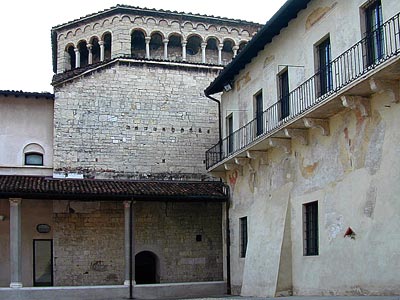I seem to have emerged from a hole somewhat in March 2014, suddenly going to lots of seminars after some time on rations. I put this partly down to the welcome presence of Another Damned Medievalist in London, which gave me a good extra reason to be in town, but also the new course I had been running that term was mostly unrolled and the Earlier Middle Ages Seminar at the Institute of Historical Research had several things on the programme that interested me, of which one was when Giorgia Vocino gave a paper on the 19th March called “Bishops in the Mirror: literary portraits and episcopal self-fashioning in early medieval Italy”.

Mosaic portrait of bishop no. 1 for this paper, Saint Ambrose of Milan. “AmbroseOfMilan“. Licensed under Public domain via Wikimedia Commons.
I knew Dottora Vocino as a face from Leeds but had never met her or her work, so this was valuable context. Her paper was about the standing of bishops in the early medieval world, and she took a complex and interesting approach to the question, taking several well-documented bishops and asking, respectively, how they presented themselves in their writings, how contemporaries report them and what their posthumous reputation was like. Her examples came from quite a chronological range: the earliest was Saint Ambrose of Milan (ruled 374-397) and the others were Pope Gregory the Great (ruled 590-604), Patriarch Paulinus of Aquileia (ruled 787-802×804) and Bishop Atto of Vercelli († 960), so perhaps it was not surprising that their own self-presentations, as Dottora Vocino characterised them, differed widely: Ambrose, despite his chiding emperors and leading mobs (this is my editorialising) presented himself primarily as a teacher of Scripture; Gregory saw the bishop as more active in the world, a shepherd more than a teacher (though a teacher too); Paulinus was most concerned with soldiering for Christ against the enemies of God, as befits one of the key scholars of the Carolingian Renaissance perhaps, by means of prayer, teaching and preaching but still more confrontational than the previous two; and Atto’s most revealing writing, a thing called the Perpendiculum is an anonymous prophetic condemnation of those who would depose kings, though it too got reused as a teaching text. Nonetheless, though they all taught only Ambrose seems really to have thought this definitional of his office, which evokes comparisons to the modern Academy that might be unkind but occur all the same.

Ivory carving of Pope Gregory the Great being inspired by the Holy Spirit, now in the Kunsthistorisches Museum, Vienna
It may then be that while those who have a quality in abundance don’t need to shout about it, those who do the same job without it still envy them, because what all of these bishops seem to have been remembered and praised (or even sometimes dispraised) for is none of the above, but instead their eloquence as speakers. Saint Augustine actually saw Ambrose speak and thought him amazing. Gregory was supposedly given his eloquence by the Holy Spirit (his senatorial education presumably assisting that gift somewhat), and although Gregory of Tours thought of his namesake as a scholar and the Liber Pontificalis remembers him mainly for building, as let’s face it it does every pope who didn’t get deposed violently, Isidore of Seville, whose brother knew Gregory, praised him mainly for public speaking. Paulinus is written up as having been preternaturally eloquent from infancy, and although we have no outside witness texts for Atto his own writings take trouble to refute charges of over-eloquence that had apparently been raised against him. This ars loquendi, art of speaking, is apparently the thing that Italian bishops got remembered for, whether they wanted that or not. Miracles, public works, and their own shared emphasis, instruction, all take a back seat to how they came over when they stood up in front of people.

I can’t find an illustration of Paulinus of Aquileia from earlier than 1790 but here at least is something he is believed to have had made, a panel from the baptismal font in the church of Cividale. Sailko [GFDL or CC-BY-SA-3.0], via Wikimedia Commons
There was some debate about why this should be. Dottora Vocino emphasised the politics that whirled around the writing of these bishops’ lives, and suggested that while miracles were a good way of indicating divine favour for the past bishops they might have been a tall order for the living ones who needed comparison to their predecessors; eloquence, on the other hand, could be presented as a divine inspiration but could also be performed by the current incumbents. Susan Reynolds wisely asked if any bishops were ever condemned for being bad speakers, but apparently there are some so it’s not just generic, however common. Alice Rio and Caroline Goodson both asked questions about regionality, seeing little of this emphasis in bishops’ lives from Francia and Southern Italy. Dottora Vocino thought that some comparisons in Francia could be found, but I think this is in some ways to be expected; she pointed out that the transmission of these famae, reputations or fames, probably needed schools, and I would add also audiences outside the schoolroom among whom such portrayals could be deployed, and both of these imply cathedral cities with urban populations, for which Northern Italy is about the most likely zone, though the South’s non-participation is still odd. It would be interesting to take the comparison across to the Byzantine world and see if the cities of Greece or Asia Minor thought of their bishops similarly. But the takeaway point for me was an old one, that people write history or similar for a reason; what someone did may not be as important for their memory as what someone later needed to do with it. Whether or not all these bishops were really talented orators we probably can’t tell, though Ambrose at least seems likely; what we can say is that while there was more to them than that, it was what served the interests of their successors to remember (perhaps because all other comparisons would have been unfavourable). As ever, it behoves us to think about what our sources did not need or want to mention before we decide what they knew.
I would have to do a lot of digging to pull together references to these various bishops works and the texts that Dottora Vocino was using, and it seems easier simply to refer you to her subsequent related publication, G. Vocino, “Under the aegis of the saints: hagiography and power in early Carolingian northern Italy” in Early Medieval Europe Vol. 22 (Oxford 2014), pp. 26-52, DOI: 10.1111/emed.12037, and hope that that will do. Sorry!



























